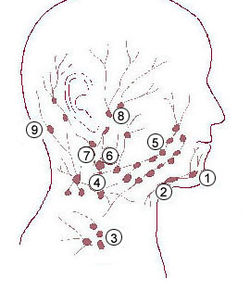| Submental lymph nodes | |
|---|---|
 1: Submental lymph nodes 2: Submandibular lymph nodes 3: Supraclavicular lymph nodes 4: Retropharyngeal lymph nodes 5: Buccinator lymph node 6: Superficial cervical lymph nodes 7: Jugular lymph nodes 8: Parotid lymph nodes 9: Retroauricular lymph nodes and occipital lymph nodes | |
 Superficial lymph glands and lymphatic vessels of head and neck. (Buccinator glands labeled at center right.) | |
| Details | |
| System | Lymphatic system |
| Identifiers | |
| Latin | nodi lymphoidei submentales |
| Anatomical terminology | |
The submental lymph nodes (or suprahyoid lymph nodes[ citation needed ]) are 2-3 lymph nodes [1] situated in the submental triangle, [1] between the anterior bellies of the digastric muscle and the hyoid bone. [2]